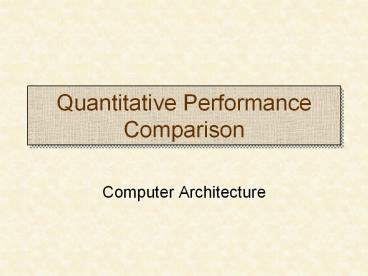Quantitative Performance Comparison - PowerPoint PPT Presentation
Title:
Quantitative Performance Comparison
Description:
Quantitative Performance Comparison Computer Architecture Need for quantitative performance comparisons Modern CPUs utilize a number of architectural advances ... – PowerPoint PPT presentation
Number of Views:47
Avg rating:3.0/5.0
Title: Quantitative Performance Comparison
1
Quantitative Performance Comparison
- Computer Architecture
2
Need for quantitative performance comparisons
- Modern CPUs utilize a number of architectural
advances - Instruction sets of CPUs are different
- RISC versus CISC
- General purposes versus ASIC (Application
Specific Integrated Circuit) CPUs - Different CPUs have different pipeline depths
- The number level of caches are different
- The clock speed of CPUs are different
- The number of ALUs vary impacting the type of
superscalar operations that CPUs can perform - The aforementioned factors affect overall CPU
performance - All of the above factors (including others) must
accounted to identify a good CPU
3
Measuring Performance
- Performance is a relative quantitative metric
that is used to compare two CPUs - Comparisons assume all other factors are
identical - Performance is represented as a ratio
- Given two computers ? and ? and a benchmark
program, then performance ratio is defined as
Performance Ratio Benchmark Execution time on ?
Performance Ratio Benchmark Execution time on ?
- Note that execution time is always measured as
the CPU time and not wall clock time. - This is important on multi-tasking machines where
multiple programs may be using the CPU
4
Example
- If computer A runs a program in 10 seconds and
computer B runs the same program in 15 seconds,
how much faster is A than B? - The performance ratio is
Execution time on A 15 1.5
Execution time on B 10 1.5
- Therefore computer A is 1.5 times faster than B
5
Program Execution Time
- CPU Time for executing a program is determined
by - The number of instructions to be executed
- The number of Clock cycles Per Instruction (CPI)
- Clock cycle time (seconds) or clock rate (Hertz)
- Recollect that cycle time and rate are inversely
related
CPU Time Instruction Count CPI
CPU Time Clock rate
The above formula can be rewritten as
CPU Time Instruction Count CPI Cycle time
Note that changing any one of the above
parameters impacts the CPU Time for executing a
program
6
Example
- Suppose we have two CPUs with the same
instruction set running the same program.
Computer A has a clock cycle time of 250 ps and a
CPI of 2.0. Computer B has a clock cycle time of
500 ps and CPI of 1.2. Which computer is faster
and by how much? - Assume program as K instructions.
- CPU Time for A 250 2 K 500K ps
- CPU Time for B 500 1.2 K 600K ps
- Therefore computer A is faster than computer B.
Performance Ratio 600K 1.2
Performance Ratio 500K 1.2
Computer A is 1.2 times faster than Computer B
7
More on CPI
- CPUs have a wide variety of instructions
- The CPI for instructions vary
- Some instructions require more cycles to complete
- Some instructions require fewer cycles to
complete - The overall average CPI of a program depends on
the mix of instructions used by the program - If CPI changes the execution times of programs
can also change - Consequently, two program with exactly the same
number of instructions (but instructions have
different CPI) can have different execution times!
8
Example
- The typical CPI for x86 architecture is shown
below - Integer Instructions 1 CPI
- Floating point instructions 2 CPI
- Which program will run faster
- Program P1 that uses 100 floating point
instructions - Program P2 that uses 50 floating point and 75
integer instructions? - Solution
- Total cycles for P1 100 2 200 cycles
- Total cycles for P2 (50 2) (75 1) 175
cycles - Therefore program P2 will run faster than program
P1 (even though P2 has more instructions)































